
With so many suspension companies and options available, picking the right suspension lift kit for your Jeep can be a daunting task. Most lifts consist of a few common and somewhat similar parts such as new coil springs, shocks, and control arms. But what's on the end of those control arms often is the deciding factor that leads you to either recommend your lift kit to others, or to hate and replace it. And if you're building your own custom suspension components, your options become almost limitless. Ultimately every type of suspension joint has its place, but it may not be on your Jeep. Here are the editors' preferences when it comes to urethane, rubber, rod ends, and more.
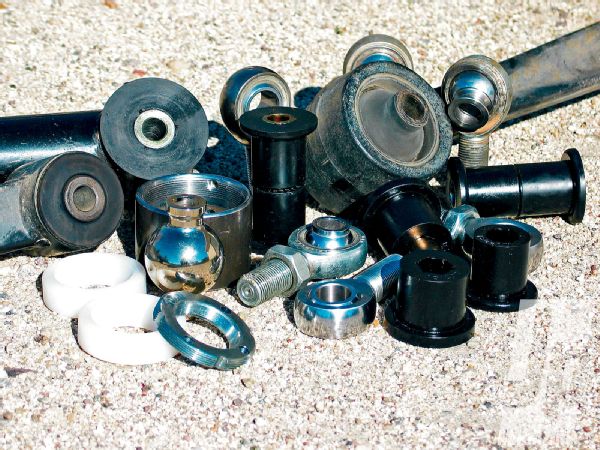
Cappa's Endings
Rubber has been used as a bushing for nearly a century and it's still used today by every automotive manufacturer. Why? Because it's inexpensive, maintenance-free, relatively easy to replace, and it works. Rubber bushings absorb shock and road noise better than any other joint available. And when properly designed and applied, they can have a very long life. However, improperly applied and low-quality rubber bushings will have shorter lives than mud tires on a top fuel dragster. It's really all about the bushing's dimensions, design, and compound. It's hard to beat factory-Jeep, as Jeep probably spends hundreds of thousands of dollars and many man-hours designing a rubber bushing for a specific application. In most cases, these rubber bushings will outlive any of the other aftermarket options. Companies such as JKS know this. That's one reason the company uses the same original-equipment Jeep bushings in its adjustable control arms, and has done so since 1997. High-quality rubber control arm bushings are the best choice for 99 percent of lifted, street-driven Jeeps. Don't be fooled by cheap imposters-most aftermarket rubber bushings do not match OE quality.
Urethane bushings are typically stiffer and less flexible than rubber. Since they are oil resistant they can last longer than rubber in some applications. However, urethane bushings generally require frequent lubrication to keep them from making a squeaky racket. In high-movement applications, such as on a suspension control arm or track bar, the bushings will eventually wear, regardless of how often you lubricate them. They aren't sealed from the elements all that well and grease attracts dirt. The dirt and grease mixture acts like an abrasive compound on the bolts, bushings, and sleeves. This wear eventually causes unwanted slop in the connection. Urethane is good for leaf spring bushings, but it wouldn't be my first choice for a control arm or track bar end.
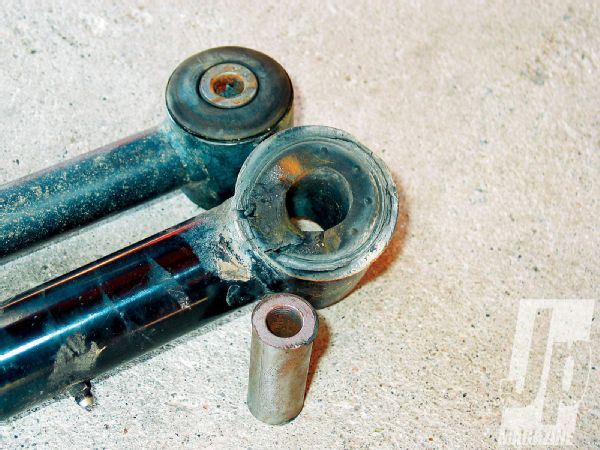 Aftermarket rubber bushings (bottom) will never outlast the high-quality OE rubber bushings (top). In our opinion, most Jeeps should have rubber control arm bushings.
Aftermarket rubber bushings (bottom) will never outlast the high-quality OE rubber bushings (top). In our opinion, most Jeeps should have rubber control arm bushings.
There are many different qualities of rod ends and the cheap ones have no place on your vehicle, but let's get one thing straight. Not all rod ends are called Heim joints. Heim is a company that builds rod ends. You wouldn't say, "I'll have a McDonalds," every time you order a hamburger, right? So with that out of the way, rod ends are for racing. Period. They are best applied in a clean environment where they are inspected or replaced every few hundred miles. If you run them through the mud and grime regularly and keep them in daily service for many thousands of miles, you'll be rewarded with loose, squeaky, and clunking control arms.
Rod ends are also rigid. Oh sure, they provide plenty of flex from side to side with the proper misalignment washers, but there is no give in a rod end. It's essentially a metal-to-metal connection. This can lead to suspension and frame brackets cracking and even tearing free. Adding a flexible bushing (rubber or urethane) to one end of a control arm can alleviate some of these stresses but it does little to increase the overall life of a rod end in a Jeep application.
Many people will disagree and maybe I'd feel differently if I lived in a wet state, but the one place where rod ends make sense to me is in the steering. That is as long as high-quality rod ends are used and they are mounted correctly. The only exception would be if the Jeep was driven daily. And like Hazel, I always use right-hand rod ends so I only need to carry one spare.
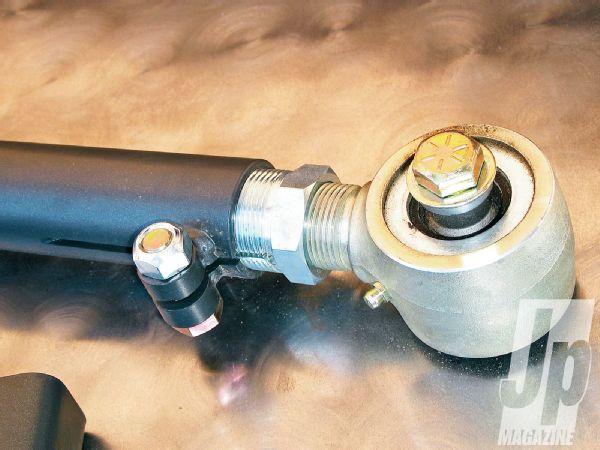 Rebuildable joints like this Currie Johnny Joint can be greased regularly to keep dirt, water, and mud out. They allow a lot of movement and will survive use on a daily driver.
Rebuildable joints like this Currie Johnny Joint can be greased regularly to keep dirt, water, and mud out. They allow a lot of movement and will survive use on a daily driver.
Rod ends make disassembly of the steering linkages much easier, especially for trail repairs. Sitting in a puddle while banging on the steering knuckle or pitman arm to get a ball joint to pop free isn't my idea of a good time. And it can't be good for the durability of any of the components involved. There really is no easy way to remove a ball joint. A pickle forks always destroys the dust boots.
Rebuildable joints such as the Super Flex joints from Rubicon Express and Johnny Joints from Currie Enterprises provide a good alternative to rod ends in suspension applications that see a lot of water and mud. They are not as harsh and rigid as rod ends, are just as flexible, but are slightly more rigid than solid rubber or urethane bushings. If you have a wet and muddy high-movement application that seems to eat even the high-quality stock Jeep rubber bushings, these greasable and rebuildable joints may be the answer. But you'll have to grease them regularly (every 3,000 miles or so), and in some cases keep them properly adjusted, or they will wear out quickly and make noise.
Hazel Apathy
There are guys who study rod end catalogs comparing tensile strength till the cows come home. Or, there are freaks and geeks who pour over bushing durometer ratings till they're blurry-eyed. I'm not one of those guys. If I'm building a steering system, my preference is actually to use quality tie-rod ends. Sure, they can wear out, bend, or break. But if they do you can usually find replacements at most local auto parts stores. The downside to using these is that you usually have to buy an expensive reamer to put the correct taper in your pitman arm or steering knuckles, and not everybody has the correct tap (or weld-in tubing inserts) to build linkages. That's why in my hardcore rigs I'll go the easier route and use the best-quality rod ends I can find. I usually buy only right-hand thread rod ends so that I only need to carry one spare. I tend to use 3/4-inch-shank, 3/4-inch-hole rod ends on the drag link so I can run high-misalignment inserts for use with 5/8-inch bolts. On the tie rod, I'll run 3/4-inch shank, 5/8-inch hold rod ends since the body is actually stronger than rod ends with a 3/4-inch hole.
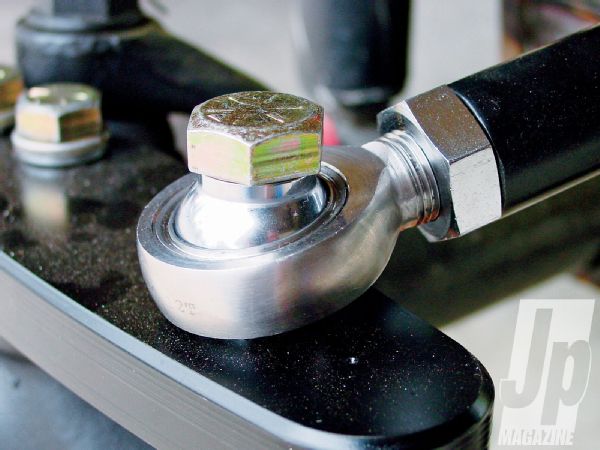 Chromoly, heavy-duty shank, high-misalignment rod ends like FK part number HRSMX10T simplify trail repairs by eliminating interference-fit tie rod ends that can be difficult to remove. But they are not ideal for daily driving, or for wet or grimy environments.
Chromoly, heavy-duty shank, high-misalignment rod ends like FK part number HRSMX10T simplify trail repairs by eliminating interference-fit tie rod ends that can be difficult to remove. But they are not ideal for daily driving, or for wet or grimy environments.
As far as suspensions go, if you're talking a dual-purpose Jeep that's going to get a lot of road miles under it, give me rubber bushings any day of the week. I've never been about getting maximum articulation. I've always felt that as long as you're running lockers it's perfectly acceptable to lift a tire. I don't need some crazy-wacky bushing in my suspension link that'll allow 500 degrees of angle if it means it's going to wear out in 500 miles and start clunking. I'd rather have a smooth, quiet ride and long life any day of the week. That said, there aren't a lot of options for rubber bushing ends if you're building your own links. With that in mind, I'd probably just do a polyurethane spring eye bushing on the frame end and a big, honkin' chromoly rod end on the axle end. At the end of the day, I just don't care enough about longevity or flex to worry too much about it. I'm just going to go with what's easiest for me to build and carry spares for.
Trasborg's Tips
I'm not a big fan of poring over catalogs to find that tenth-of-a-thousandth larger bushing. Really when you get down to it, you can bench race rod ends, bushings, and everything else till the cows come home and still be wrong. I tend to go back to what has worked for me in the past.
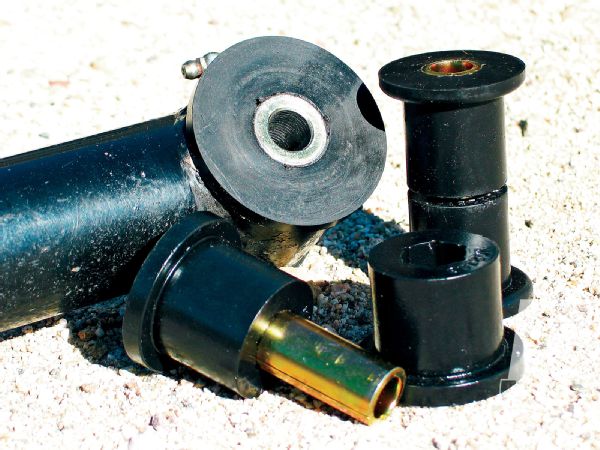 Urethane bushings may not clunk like old rod ends, but when not lubricated regularly their squeaking will drive you batty. Over time, though, sand and grime in the grease can wear the bushings and sleeves.
Urethane bushings may not clunk like old rod ends, but when not lubricated regularly their squeaking will drive you batty. Over time, though, sand and grime in the grease can wear the bushings and sleeves.
In the steering that means tie-rod ends. I don't have the luxury of having a trailer-queen Jeep, and I'm always playing in some mud somewhere, so the safety and greasability of a regular old tie-rod-end is where it is at for me. I've used big high-quality rod ends before, and while it did simplify the installation, I found I was replacing them within a year and that just gets old quick. I got a tapered reamer and never looked back. My two favorite tie-rod-ends are going to be the good old stock Jeep style and taper and Chevy one-ton parts. I tend to get the Chevy parts from Parts Mike because of the good prices and availability of different custom parts; this makes whatever I'm doing easy-and on the odd chance I blow one up somewhere, I can usually find a replacement at whatever parts store is in town.
For the control arms, I lean towards rubber because I just don't need that much flex. I'm not trying to win any ramp competitions. If I do want something that will flex a bit better, I'll use a ball-and-socket joint on one end and rubber on the other. I find rubber on one end greatly reduces the noise in the Jeep not only in the Unitbody rigs, but also for the body-on-frame ones too. I've got a ton of miles on both Currie Enterprises Johnny Joints and the Rubicon Express flex joints and wouldn't hesitate to put either one in my suspension. Teraflex also has some way-beefy ball-and-socket and rubber-bushed ends that should handle whatever beating you toss their way.
For the track bar, I'm going to run control-arm style ends that actually allow for rotational movement, unlike the tie-rod-end style the factory part used. I also try to bump the bolt size up to 1/2-inch-diameter whenever possible. In my opinion, the bolt-size and tie-rod-end design were just Jeep's way of messing with us. Every problem I've had in a coil-sprung Jeep has been traced back to the factory track bar ends or mounts. By upgrading to through-bolt style ends at both ends, the track bar is free to rotate as the axle droops and compresses. Rubicon Express makes a good replacement kit for just about any coil-inflicted Jeep.